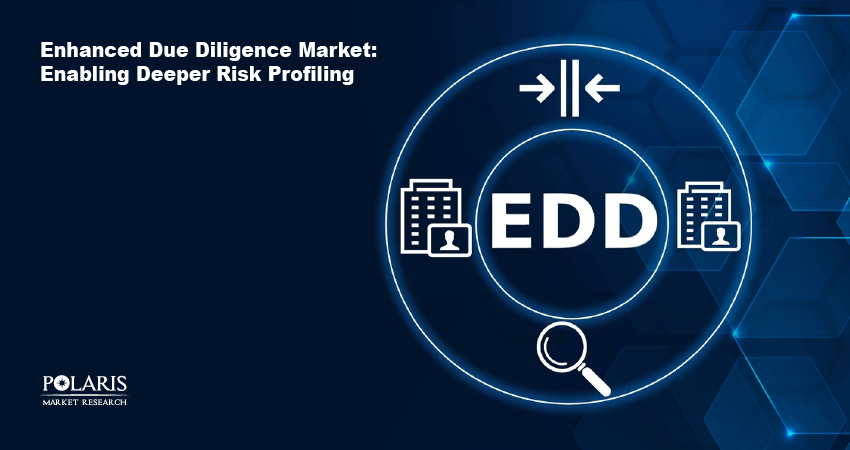Enhanced Due Diligence Market: Enabling Deeper Risk Profiling

Financial crime has become highly sophisticated over the years. As such, financial institutions and regulators are raising the bar when it comes to compliance. Customer due diligence (CDD) provides the basic level of anti-money laundering (AML) checks. But enhanced due diligence (EDD) is now important for higher-risk customers, countries, and transactions.
So, what exactly is enhanced due diligence? And what is it about EDD that makes it so important in the modern financial world? This blog post explains to you the essentials of EDD. It covers the key factors driving the demand for EDD solutions. The impact of artificial intelligence (AI) on the enhanced due diligence market has also been detailed. Let’s explore!
What Is Enhanced Due Diligence?
EDD is a highly rigorous form of risk and identity assessment. It is applied for customers or transactions where there’s a high risk of money laundering. EDD goes beyond basic verification. It develops a complete picture of the financial behavior of the customer and their business model. The funding source and the beneficiaries are also assessed.
Why Is EDD Important?
EDD for KYC is highly important. This is due to the high monetary value of companies, individuals, and transactions it applies to. Of course, fraud on a small scale can lead to significant losses in the long term. However, financial crimes on a large level can give bigger and more immediate shocks. Additionally, high-value money laundering is often used for funding criminal activities on a large scale.
This makes it important for financial institutions to invest in EDD to maintain their reputation. If EDD requirements aren’t met by a financial institution, they can take a huge reputational hit if a large-scale financial crime occurs.
What Are Enhanced Due Diligence Market Metrics?
The latest analysis of the enhanced due diligence market by Polaris Market Research reveals the market to witness sustained growth. The market for EDD stood at USD 3.20 billion in 2024. It is projected to account for a CAGR of 11.2% between 2025 and 2034.
The rising incidence of financial fraud and money laundering has prompted banks and financial institutions to invest in advanced EDD solutions that are capable of continuously assessing behavioral changes. The rising digitalization of financial services across the globe is also having a favorable impact on the enhanced due diligence market expansion.
How Is Enhanced Due Diligence Conducted?
There are several steps involved in the enhanced due diligence process. The enterprise, governance, risk & compliance market can provide an effective framework for conducting EDD. These various EDD steps include:
Getting Additional Relevant Identification Credentials
The first step involves getting more information about the part of the customer’s identity representing increased risk. For example, if an individual is politically exposed, the financial institution must look for the title of the person and what kind of position they hold. Their influence on society and business also needed to be checked. If the customer is a legal entity or company, the institution needs to collect information about things such as corporate registration documents.
Identifying the Sources and Ultimate Owners of Assets
Enhanced due diligence also involves collecting information about the clients, suppliers, and legal structures of the customers. This is done to identify the ultimate beneficial ownership of the account’s asset. It also helps assess whether the value of the customer's real assets is linked to their intangible and financial assets. In case of any discrepancies, the customers must be able to justify them with appropriate documents.
Analyzing Customer’s Transaction History
A financial institution needs to look for data about the previous transactions of the customer. Things such as the business partners of the customer, the mode of their transaction, transaction time, and the value of products/services provided need to be assessed. This is especially important for transactions that involve the use of cryptocurrencies. A number of crypto transactions made in a short time frame is something that requires further assessment.
Checking Media Sources for Current or Past Negative Coverage
Financial institutions can get information about the reputation of a customer through their media coverage. They can look for public reports, press releases, news stories, and even social media accounts of the customer. If the customer has received media coverage for suspicious or illegal activities, it may indicate that they are risky enough and need closer monitoring. A high risk, such as the customer being currently under scurtinity for financial crime, can signal that going forward with the business relationship isn't appropriate.
Making In-Person Visits
Companies and other legal entities controlling the financial account on behalf of other people need to have physical locations. A representative of the financial institution can make a visit to the location to check if the descriptions and addresses provided by the customer and those of the physical location are similar.
Writing a Report About the Findings
Once done with all the above steps, a financial institution must synthesize its findings into a detailed report. This helps determine the nature and degree of the financial risk represented by the customer. From this point, the financial institution can make a decision as to whether it feels secure in continuing business with the customer.
How AI is Transforming Enhanced Due Diligence?
The artificial intelligence market is having a favorable impact on the enhanced due diligence sector. AI is capable of analyzing large volumes of customer data. This helps in generating accurate and real-time risk scores. Using machine learning models, institutions can improve their fraud detection capabilities. AI can monitor customers and their transaction behavior in real-time.
Conclusion
EDD is a multifaceted process. It involves several steps for assessing the potential risks associated with high-risk customers. A combination of expert knowledge, advanced technology, and regulatory understanding is required for effective identification and mitigation of risks. The key players in the enhanced due diligence market are increasingly focusing on new product launches and partnerships to improve their offerings.

